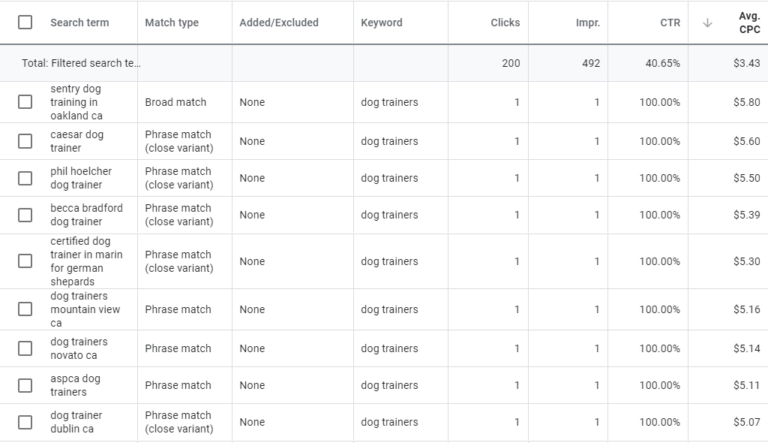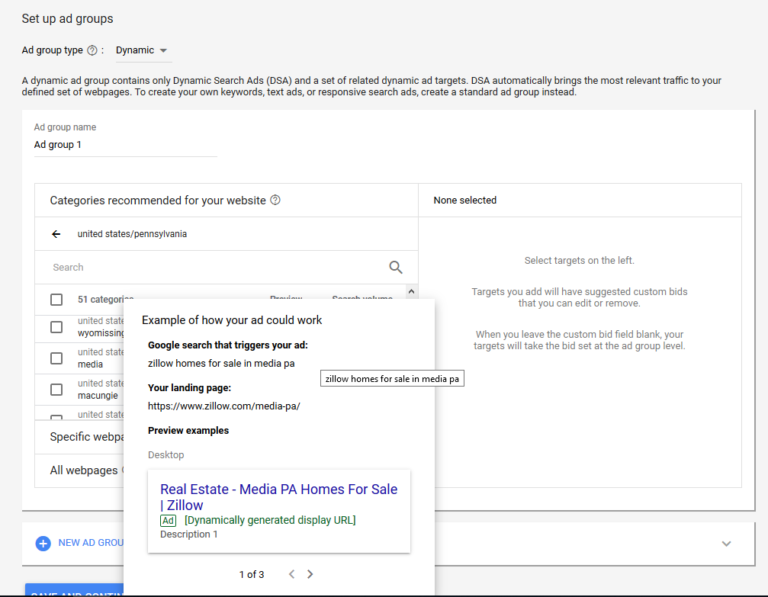10 Nov 5 Innovative PPC Tactics to Try Today via @navahf
Managing pay-per-click campaigns (be they search, social, or display based) usually becomes a series of habitual tasks.
While this allows for stability and scalability, sometimes it causes blind-spots in legacy accounts (working together more than a year).
Here are my favorite tactics to break the mold.
Tactic 1: A Single Long-Tail Broad Match Keyword, with Every Other Word Added As Negatives
If there’s one universal truth to PPC managers, it’s that we value control over everything.
Broad match is the antithesis of that control.
Broad match keywords become grounded in the actual syntax of the keyword chosen when they have at least 5 words.
Additionally, broad match opens up access to keyword concepts that would be too expensive to actively invest in.


When you adopt this strategy it’s crucial you take the following steps:
- Every keyword you’re actively targeting gets added as an exact match negative. This will ensure your broad match keyword can focus on new query ideas/one off searches, while your core campaigns can deliver leads/sales via proven keyword concepts.
- If an applicable in-market audience exists, layer it on the broad ad group/campaign so you can prequalify the data acquisition.
- Audit your queries regularly, and be open to swapping keyword concepts you’re actively targeting for ideas your broad match keyword secures (provided there’s enough volume/the business case is there).
- Campaigns should only have one broad match keyword (sequestered away in its own ad group). Any more than that, and the data acquisition will turn into waste.
Tactic 2: Lead with Display, Remarket with Search
Not every business hast the budget for Google search as the first touch with a prospect.
Display is here to bring the curated audience worth investing in.
The beauty of custom intent, custom affinity, and in-market audiences is that they represent prequalified leads another brand paid for.


Layering these audiences on a display campaign (where the cost-per-click are dramatically cheaper) allows your brand to curate a list of ideal prospects – ripe for the picking by branded search and/or RLSA.
All ad types should be aligned with the target audience, and display is no exception.
Display creative needs to be attention-grabbing, and can lean on image, text, or a hybrid approach.
Hybrid creative can look like this:


This ad achieves the following:
- Grabs the user’s attention with a bold statement with focusing images.
- Highlights the product with a strong call to action.
- Subtlety engages the user to think about their subscription model as opposed to a one-off purchase.
Leveraging text-heavy display well is tricky, but possible:


This ad achieves the following:
- Entices the prospect with an offer.
- The call to action is clear and stands out from the rest of the creative.
- The both the product brand and vendor brand are clearly displayed for ease of retention.
If you decide to leverage this tactic, it’s vital two considerations are in place:
- Your industry is approved for remarketing. Full list of restricted industries is here.
- You have your remarketing tag and Facebook pixel in place.
Depending on the initiative, the display campaign may be sending folks to a microsite or subdomain, so it’s important to confirm the tracking codes used on your main site make it over to your PPC landing pages.
Tactic 3: Sequester Branded & Competitor Terms in Their Own Campaigns
Regardless of where you fall on the branded/competitor campaign debate, there is value in protecting your general service terms from false positive (branded) and false negative (competitor) metrics.
Most keywords are capable of adding in branded or competitor terms to their queries, creating false positives/negatives in the metrics.

 Expensive competitors driving up the cost of queries
Expensive competitors driving up the cost of queriesWhen branded and competitor terms live in their own campaigns (and are made negatives everywhere else), campaigns are able to focus on the main job they’ve been given.
Campaigns jobs range from:
- General service/product: Core service offerings and products offered – ad groups are different ways of referring to that service/product.
- Location-based: Campaigns have very similar structure but are targeted to different location so they’re not competing with each other and can have ads/keywords that account for how that location searches/thinks.
- Buyer Persona: While this usually makes more sense at the ad group level, if the buyer persona represents different margins/profit potential, it can make sense to set campaigns in line with prospect potential value.
- Branded: A safe space for the cheaper and higher converting queries revolving around your brand, as well as a focused spot for branded creative.
- Competitor: Top five to seven competitors with a competitor per ad group that allows you to set specific messaging in line with why you’re better.
- Experimental campaigns: Safe spaces for crazy ideas that you don’t actually want to run but are “forced” to by team members/clients
Every campaign represents additional budget, so it’s important to choose the jobs that will serve your brand best, as well as allow you to have an account that’s easy to manage.
Tactic 4: Use DSA for Keyword Research
Dynamic Search Ads (DSA) represents a beautiful hybrid approach between SEO and PPC – empowering PPC campaigns through well SEO’ed sites.
DSA functions by allowing Google to crawl the site, and match the best landing page to the user’s query (if it was included in the dynamic target).


There are two main benefits to DSA:
- Empowering budgets to support hundreds/thousands of landing pages without needing hundreds of campaigns.
- Teaching us how our prospects search and at what cost.
All keywords you’re targeting in other campaigns need to be made negatives in the DSA campaign.
By making the keywords negatives, you ensure your actively chosen keywords get a fair shake to be profitable, and DSA can focus on net new ideas.
It is vital regular audits of the search term reports accompany DSA. You’ll be checking for the following:
- Keyword concepts you want to actively target.
- Keyword concepts that need to be made negatives.
- Auction price range of valuable queries.


Tactic 5: Invest Aggressively in the Beginning and Then Roll Spend Back
Most campaigns begin with a small testing budget – advertisers are loath to invest until they see results.
Yet if there isn’t enough fuel for the keyword concepts/targets chosen, the learning period can drag causing waste.
If the campaign is operating at less than 30% impression share (of all available impressions, the amount it’s securing), that means at least 70% of potential prospects aren’t getting access to your brand.


Sometimes, new campaigns need to be less ambitious in scope (targeting only part of the offerings/some of the market) to allow the budget to fully fuel their learning periods.
The first month of a campaign should get a 15%-20% increase in budget for data acquisition (how prospects search, what they will cost, and to teach the ad networks the value of the campaign).
After the initial learning period (minimum of two weeks but can go for the full month), you’ll have the intel to make educated and profitable decisions about the account.
This can mean:
- Rolling back spend to ideal parameters.
- Leveraging a smart (conversion-oriented) bidding strategy.
- Campaign optimizations (negatives, new keywords/ad groups, creative choices).
Final Thoughts
Our job as PPC marketers is to consonantly push the boundaries of what’s possible in profit and scale.
Yet if we add in too many variables, we won’t know what was behind our success.
Give yourself a full learning period as you test out these innovations.
More Resources:
- 7 Expert Tips to Boost Your PPC Performance Today
- How to Develop Your PPC Strategy
- PPC 101: A Complete Guide to PPC Marketing Basics
Image Credits
All screenshots taken by author, October 2019
Sorry, the comment form is closed at this time.